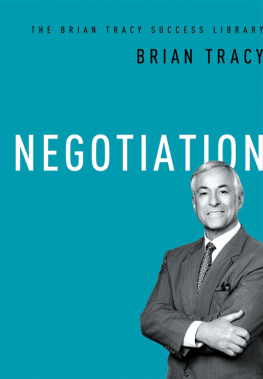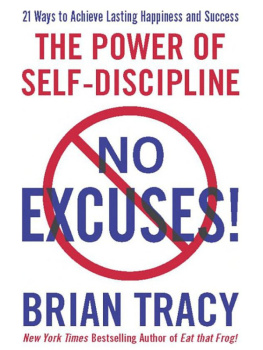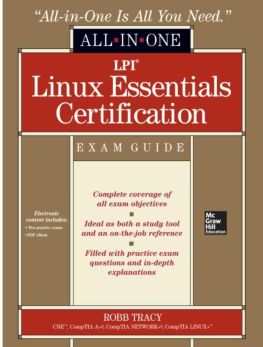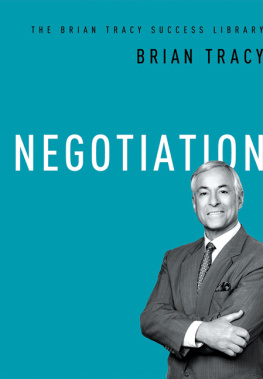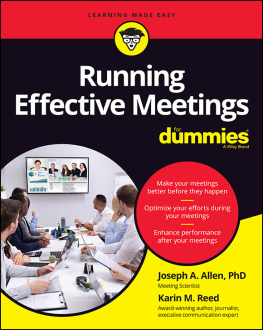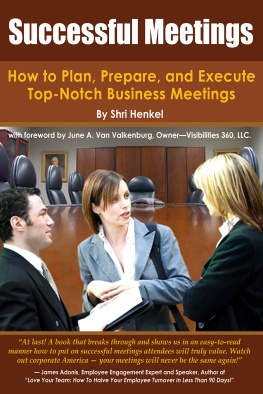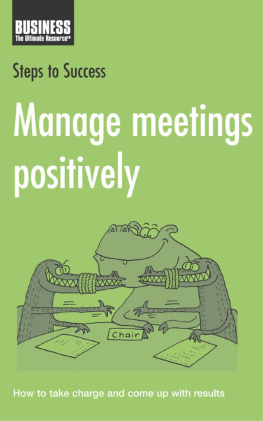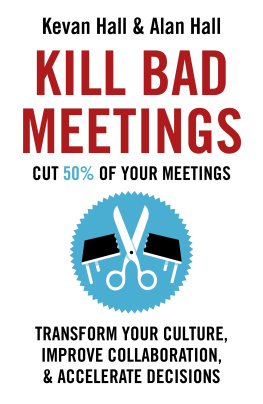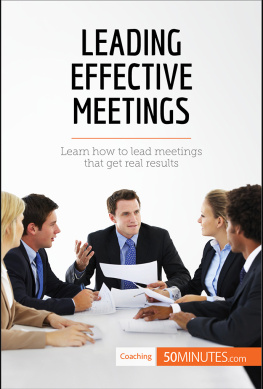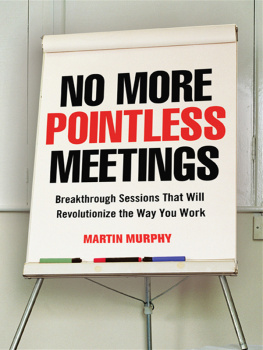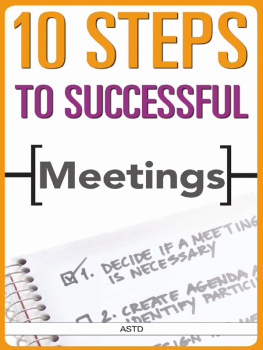Thank you for downloading this AMACOM eBook.
Sign up for our newsletter, AMACOM BookAlert, and receive special offers, access to free samples, and info on the latest new releases from AMACOM, the book publishing division of American Management Association.
To sign up, visit our website: www.amacombooks.org

MEETINGS THAT GET RESULTS
MEETINGS THAT
GET RESULTS
BRIAN TRACY

CONTENTS
Introduction
Meetings are an essential part of the life of every organization. As a manager, one-quarter or more of your career will be spent in group meetings. As much as 70 percent to 80 percent of your career is going to be spent face-to-face and one-on-one with other people as well as in groups.
The more people there are in your workplace and the greater the complexity required for the performance of interrelated tasks, the more necessary it is for people to meet in groups to solve problems, make decisions, share information, and exchange views and opinions.
My favorite expression is that meetings are management in action. They are a major opportunity for you to display managerial competence (or lack thereof) as well as to develop your communication skills, to influence and persuade others, and to advance the goals of the organization.
However, meetings are like advertising. It is estimated that 50 percent of the dollars spent on advertising are wasted, but nobody knows which 50 percent it is. It is also estimated that half of the time spent in meetings is wasted, but nobody knows how to eliminate the unnecessary half.
Many meetings go on too long, are ineffective, are not results-oriented, or are vague and directionless. Nonetheless, they cannot be avoided. Meetings remain absolutely essential in the business environment and essential to your success.
Influence Others
In this book, you will learn how to manage and participate in meetings more effectively so that you get the maximum return on the time invested in meeting with other people.
As a manager, the way you plan and conduct a meeting and the way you perform in a meeting are major factors in your career success. In a meeting, you are being observed by both your supervisors and your subordinates. Your superiors especially will be very alert to the quality and quantity of contribution you make in a meeting. If you handle yourself well in meetings, youll be hallmarked as an up-and-coming leader. You can shine and be a star contributor, or you can bomb. Its up to you, but you cannot hide.
If you are the leader, your subordinates will evaluate your credibility, competence, intelligence, and your general personality by the way you conduct meetings.
Successful executives are those who know how to run meetings well and perform effectively in a meeting environment. Peter Drucker said that meetings are the primary tool of management. Since a major part of your career will be spent in meetings, it is essential for your success that you learn how to get the very most out of meetings and how to ensure that the meetings in which you participate achieve the results desired.
Save Time
If you become excellent in participating in and conducting meetings, you can add as much as 40 percent of lost time back into your day for doing productive work and getting more results, which will help you move rapidly up the corporate ladder. But if you cannot function excellently in meetings, you cannot be successful in management.
In this book, we are going to talk about two main types of meetings. The first one, with which you are most familiar, is the group meeting where people come together for a variety of reasons. The second is the one-on-one meeting, where you meet with one or a small number of people to negotiate, interview, discipline, hire, fire, reward, delegate, or carry out other managerial activities.
This book includes twenty-one key ideas derived from many years of study and research into the organization and coordination of effective meetings. When you begin incorporating these ideas, or even some of them, into your meeting management strategy, you will become so much more effective in meetings, and probably quite quickly, that you will not believe the difference.
ONE
Types of Meetings
Thomas J. Watson, the founder of IBM, said that the starting point in making meetings more effective is to think carefully about the meeting in advance.
Determine what kind of meeting is being held and then structure the meeting in such a way that you maximize the time of the participants. Too many meetings are held spontaneously and ad hoc, with no real thought, particular preparation, purpose, or clear goal in mind.
There are five different types of meetings. Some of them overlap, but each meeting type has its own requirements.
Information Sharing
The first is an information-sharing meeting. This is when you bring people together to review progress and to share information in a roundtable way. The participants role is to bring others up-to-date on their activities. A typical staff meeting is a good example.
This is a process-oriented meeting. It is not aimed at a specific target or goal but is part of an ongoing process and is a very important means of communication. Most executives polled estimate that information-sharing meetings are the second most important form of communication in an organization. (The most important form is the one-on-one meeting.)
Problem Solving
The second type of meeting is for problem solving. These meetings are goal- and mission-oriented. The purpose of the meeting is to find a solution to a specific problem. These meetings take place frequently, usually ad hoc, and are put together quickly. Problem-solving meetings vary in length depending on the size and complexity of the problem to be solved.
Operational
The third type of meeting is an operational meeting when you bring together people from different departments. The purpose of this kind of meeting is to acquaint representatives of different departments of a company with the big picture.
Committee
The fourth type of meeting is the committee meeting. This is a regularly scheduled meeting with a standard format and agenda, and with the same group of people who come together to monitor and review progress, plan ongoing activities, and give and receive feedback.
A good example of the committee meeting is the quality circle or quality team meeting. This is where a committee of employees gets together on a regular basis to review past efforts, talk about what they can do to improve quality, and develop recommendations for management.
Teaching and Training
The fifth type of meeting is the teaching and training or seminar meeting. The purpose here is to instruct the participants in some new subject. An example would be when new equipment or technology is being introduced, or when you are initiating a new program.
Many meetings have elements of all five types. But to make a meeting effective, it must be clear to everyone which basic type of meeting is being held.
TWO
Define the Purpose of the Meeting
The starting point of meeting effectiveness is clarity of purpose. What is the reason for the meeting in the first place? Think it through in advance and ask why the meeting is being held at all. Guard against the tendency of slipping into the habit of holding meetings just for the sake of them.
Next page

